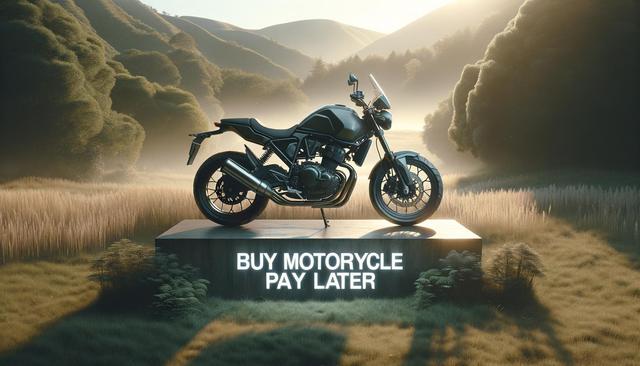Understanding Pay Later Motorcycle Plans
Buying a motorcycle through a pay later plan allows riders to spread the cost of their new bike over time instead of paying the full amount upfront. This type of financing is structured to suit different budgets, making motorcycles more accessible to a wider range of consumers. Before you commit, it’s important to understand how these plans work, their terms, and what to expect in terms of financial responsibility.
Typically, these plans involve a fixed-term agreement where you pay weekly or monthly installments over a set period. The duration can range from a few months to several years, depending on the lender and the price of the bike. Interest rates also vary, and some plans may include promotional periods with reduced or zero interest. However, it’s crucial to read the terms carefully to avoid unexpected fees.
Key things to check before signing a pay later agreement include:
- The total cost of the motorcycle with interest
- Late payment penalties
- Early repayment options
- Insurance and registration inclusion
Understanding these details can help you pick a plan that not only gets you on the road quickly but also keeps your financial health intact.
Evaluating Your Budget and Needs
Before deciding on a pay later plan, take a close look at your monthly income and expenses. This will help you determine what you can realistically afford without putting stress on your finances. A motorcycle might seem affordable on paper, but when you factor in fuel, maintenance, insurance, and other running costs, the total monthly outlay might be higher than expected.
Start by calculating your disposable income—what’s left after paying for essentials like rent, food, and bills. Make sure the planned motorcycle payment fits comfortably within that figure. It’s also wise to leave some buffer for unexpected expenses, so you’re not caught off guard by sudden repairs or missed payments.
Think about your riding habits too. Are you using the bike for daily commutes, weekend rides, or occasional trips? Your usage will impact both the type of motorcycle you need and the plan you should choose. More frequent use may justify a slightly higher payment for a reliable model that offers good mileage and low maintenance.
Being honest about your financial situation and riding needs ensures you select a pay later plan that works for you over the long term.
Choosing the Right Motorcycle and Plan
Once you’ve assessed your budget and needs, the next step is choosing the right motorcycle and the appropriate pay later plan. There’s a wide range of models available, from lightweight scooters to powerful cruisers, and each comes with its own pricing and financing options. Your lifestyle, experience level, and intended use should guide your selection.
Visit multiple dealerships or online platforms to compare prices and financing offers. Don’t rush into the first available plan—take the time to understand the differences in terms offered by different providers. Some may offer lower interest rates but require a higher down payment, while others might have more flexible payment terms but a higher total cost in the end.
Important factors to consider when selecting a motorcycle and a pay later plan:
- Monthly payment amount and duration
- Total repayment cost
- Interest rate and APR
- Customer service and support from the financing company
Balancing affordability with quality ensures you’re not just riding a motorcycle you like, but also one that makes financial sense.
Application Process and Approval Requirements
Applying for a motorcycle pay later plan typically involves a few standard steps. Most providers will require you to submit an application form along with proof of income, identification, and possibly a credit check. These documents help the lender verify your ability to repay the loan and assess the terms they can offer you.
While some pay later options are open to people with limited credit history, having a good credit score can give you access to more favorable interest rates and lower monthly payments. If your credit history is limited or poor, you may be asked for a co-signer or a larger down payment to offset the perceived risk.
Typical requirements for approval may include:
- Proof of steady income (pay slips, tax returns, etc.)
- Valid driver’s license and ID
- Bank statements
- Initial down payment (amount varies)
The application process is often quick, with some providers offering same-day approval. Once approved, you’ll sign a contract detailing the payment schedule, interest, and any additional fees. Always read the contract thoroughly before signing to avoid surprises later.
Managing Payments and Staying on Track
After you’ve secured your motorcycle and the pay later plan is in place, the next critical step is managing your payments effectively. Staying on top of your repayment schedule is essential to maintaining your credit score and avoiding late fees or penalties. Many providers offer automated payment options, which can help ensure you never miss a due date.
In addition to making regular payments, it’s wise to monitor your account and keep records of each transaction. This can help you spot any discrepancies and provide proof of payments if needed. If your financial situation changes—due to job loss or unexpected expenses—contact your lender immediately. Some may offer temporary relief options or restructuring of your payment plan.
Tips for staying on track with your motorcycle financing:
- Set reminders or use auto-pay features
- Keep a monthly budget to track expenses
- Review your payment history regularly
- Communicate with the lender if issues arise
Responsible management of your pay later plan not only helps you keep your bike but also builds a positive credit history that can benefit you in future purchases.
Conclusion: Ride Smart with a Plan That Fits
Buying a motorcycle through a pay later option offers convenience, flexibility, and the chance to ride sooner rather than later. However, it’s not a decision to take lightly. From understanding the terms and evaluating your budget to choosing the right bike and managing payments, every step requires careful thought and planning. This approach empowers you to enjoy the freedom of the road without compromising your financial stability. Whether you’re a first-time buyer or looking to upgrade, staying informed and realistic will help make your ride smooth and stress-free.


